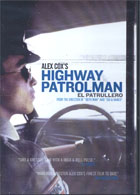
Highway Patrolman (El Patrullero) 2011
Distributed by Microcinema International/Microcinema DVD, 71 Stevenson St. Suite 400, San Francisco, CA 94105; 415-447-9750
Producer n/a
Directed by Alex Cox
DVD, color, 100 min.
College - General Adult
Film Studies
Date Entered: 01/15/2013
Reviewed by Oksana Dykyj, Head, Visual Media Resources, Concordia University, MontrealHighway Patrolman (El Patrullero), Alex Cox’s 1991 film, follows on the work he did earlier in Straight to Hell (1987) and builds on the aesthetic of his early films, Repo Man (1984) and Sid and Nancy (1986). The film can be viewed on so many different levels that it is almost unique for the period. Director Robert Rodriquez broke out with El Mariachi a year later in 1992 and could certainly be indebted to Cox for his strong contribution to the trans-genre anthology of violent action/anti-establishment/pseudo-western found in Highway Patrolman. The more contemporary editions of this cross-pollinated genre are Oliver Stone’s Savages (2012) and Quentin Tarantino’s Django Unchained (2012).
According to Alex Cox’s website, they shot on location all over northern Mexico. They began in Parras, Coahuila, was coincidently the town where Sam Peckinpah filmed The Wild Bunch (1969). The story can be viewed as an homage to the evolution of a number of genres: from family comedy, to work training comedy, to marital comedy. It references many earlier as well as contemporary film and television genres very subtly, as a brief nod to them. But then, as the film progresses, there is a shift to the more serious and ironic undertone of contemporary film noir and neo-western. The arid landscape acts as a foil to the action and sets up the look of future films dealing with crime in Mexico.
The film follows Pedro (Roberto Sosa) who enrolls in the Federal Highway Patrol and goes through training against his father’s wishes but to the pride of the rest of his family. He is immediately thrown into dealing with corruption at all levels of his work but manages to get married and start a family as well as establish a relationship with a local prostitute. His work in a poor rural area becomes more dangerous as he is exposed to higher levels of corruption and drug dealers. Violence ensues causing him to re-evaluate his life. The DVD also includes bonus features such as an audio commentary by the director and producer as well as a making-of documentary. More importantly, Cox’s Edge City, a 35-minute student film he made for $8000 when he was at UCLA between 1977 and 1980, is included. It easily demonstrates the punk aesthetic of the period and is followed by a 5-minute on-camera discussion by Cox comparing his student film to Highway Patrolman. The special features on this disc are as important as the main film and provide an excellent background to the understanding of Cox’s work. Highway Patrolman is recommended for Film Studies and anyone interested in the history of popular culture.